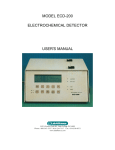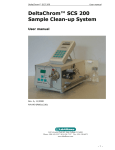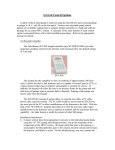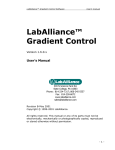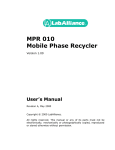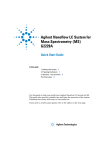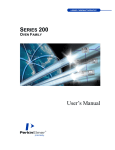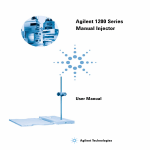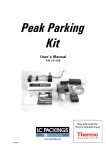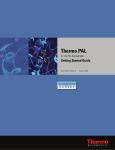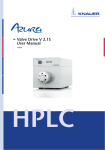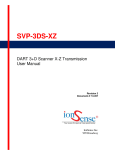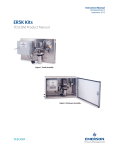Download injection valve manual - Scientific Systems | HPLC Pumps
Transcript
ANALYTICAL INJECTION VALVE TYPES C and D USER’S MANUAL Analytical injection valve types C and D 2 Analytical injection valve types C and D CONTENTS 1. COMPLETENESS AND NOMENCLATURE...............................................................3 1.1 Accessories .............................................................................................................3 1.2 Spare parts...............................................................................................................3 2. SPECIFICATION ............................................................................................................3 3. USE AND DESCRIPTION.............................................................................................4 3.1 Use ............................................................................................................................4 3.2 Function of the product............................................................................................4 4. OPERATION INSTRUCTIONS......................................................................................5 4.1 Installation instructions.............................................................................................5 4.2 Installation of a switch to the valve type D .............................................................5 4.3 Start up procedure...................................................................................................5 4.4 Maintenance.............................................................................................................6 5. TROUBLESHOOTING ...................................................................................................6 5.1 Instructions to minor fault remedy ..........................................................................6 6. SERVICE ORGANIZATIONS ........................................................................................7 6.1 Warranty and post-warranty repairs.......................................................................7 7. WARRANTY...................................................................................................................7 7.1 Warranty conditions .................................................................................................7 3 Analytical injection valve types C and D 1. COMPLETENESS OF DELIVERY Unless agreed otherwise, the delivery of one analytical injection valve involves one copy of this manual, the guarantee and delivery sheets, and accessories, according to the list given in the following paragraph. 1.1 Accessories Stainless steel pass-through screw UNF 10 ......................................... Ferrule 1/16” O.D. stainless steel ......................................................... Stainless steel capillary 1.5 mm (1/16”) x 0.5 mm, 50 mm .................. LUER injection needle, dia. 0.71 mm, 2” (50.4 mm) ........................... Screw M4 x 6 ......................................................................................... Start switch with cable (push button series M312)-only valve type D ... Part No. Qty EC-8012............... EC-8008............... EC-8001............... EC-2008............... EC-OC8............... EC-5055............... 4 ea 4 ea 2 ea 1 ea 2 ea 1 ea 1.2 Spare parts Part No. Cover 3 ..................................................................................................... Rotor seal 3 .............................................................................................. Stainless steel pass-through screw UNF 10 ............................................ errule 1/16” O.D. stainless steel .............................................................. Stainless steel capillary 1.5 mm (1/16”) x 0.5 mm, 50 mm ..................... LUER injection needle, dia. 0.71 mm, 2” (50.4 mm) .............................. Screw M4 x 6 ............................................................................................ Start switch with cable (push button series M312)-only valve type D ...... EC-OD001 EC-OD002 EC-8012 EC-8008 EC-8001 EC-2008 EC-OC8 EC-5055 2. SPECIFICATIONS Maximum operating pressure ...................................................................... 35 MPa Capillary connection .......................................................... UNF 10 standard thread Control ............................................................................................................. Manual Injection loop ....................................................................................... exchangeable Volume of injection loop ............................................................................... min 3 µl Dimensions ............................................................................... dia. 41 mm / 72 mm Weight ............................................................................................................... 0.5 kg Material ...................................................................................stainless steel, Vespel 4 Analytical injection valve types C and D 3. USE AND DESCRIPTION 3.1 Use The analytical injection valve is a de-vice intended for injection of liquid samples to inlets of chromatographic columns exhibiting high counter pressure. The concept of the valve is designed so that the operators’ share on deterioration of reproducibility would be reduced to a minimum. Fig. 1 Block diagram of the valve An injection loop is exchangeable and may be filled using a syringe with a needle supplied in the accessories, or by a Hamilton type syringe with an appropriate needle. Injected volume of a sample is by a exchangeable loop used (3 µl to 1 ml) fastened to the back of the valve. The loop is not the accessory of the valves. The valve D is modification of the valve type C and has additional switch, which makes possible to start an integrator (for example CSW), LCD 2084 detector software and LCP 4100 pump software, simultaneously with switching the valve to the INJECT position. 3.2 Function of the product The valve consists of two basic parts - a fixed stator and a rotating rotor. The rotor is fixed to a handle and is manually controlled. The stator consists of three stainless steel bodies. Six openings are in the rear body to connect capillaries and injection loop, while the inside of the body has highly polished surfaces to form an efficient seal. The rotor contains a gasket of a special material (polyimide), which is pressed against the sealing surface of the stator by a system of springs and an axial bearing to allow for smooth movement. At the same time, several by-passing channels are in the rotor. A guide of an injection needle for filling the injection loop is in the rotor. When inserted the needle is sealed at its end by a flexible insert to prevent a sample from leaking from the valve. The sealing force applied to the needle may be adjusted when the rotor is disassembled. 5 Analytical injection valve types C and D 4. OPERATION INSTRUCTIONS 4.1 Installation instructions Fix the valve with two M4 screws to a panel or another holder, in which holes are bored, according to the fig. 2. Remove the handle supporting a front knob from the valve. When the handle is removed, access to two fixing threads may be obtained. Provisionally, the valve may also be fixed to a laboratory stand. Fix the injection loop of a selected volume to the openings No. 3 and 6 in the rear part using ferrules 1/16” and pass-through screws UNF 10 . Threads are of a standard UNF 10 dimension for liquid chromatography. Fix the capillary leading from a pump to the opening No.2, and the capillary connected to a column to the opening No.1. Fix capillaries supplied in the accessory to openings No. 4 and 5 and direct them to drain. Fig. 2 Mounting holes in a panel 4.2 Installation of a switch to the valve type D The valve may be equipped with a switch with cable (push button series M312), screwed to a middle part of the valve with a M7 x 0.75 thread. If the valve is supplied together with a CSW chromatography station, the push button forms a part of the delivery together with cables; if delivered separate, the switch with cable is included in the valve accessories. Remove spring washer from the push button and screw nut up to the stop. The valve turns to the “INJECT” position. In this position, screw the push button to the valve as deep as the contacts of the push button are switched (check using an ohmmeter). Secure the push button in the correct position with a nut screwed in advance. Check for the function of the valve by switching on and off several times, if the push button is disconnected in the “LOAD” position and reliably connected in the “INJECT” position. If an attempt is made to mount the push button to the valve in the “LOAD” position, there is a risk of its breaking when the valve is switched to the “INJECT” position, resulting in necessity to disassemble the whole valve and replace broken parts. 4.3 Start up procedure When the valve is installed, turn the handle to the leftmost (LOAD) position. After the pump is started, pumped liquid passes through one of the bypassing channels directly to the column. Now it is possible to fill the loop with a sample. Inject the sample only with a syringe designed for this purpose, i.e., that with a needle for Rheodyne injectors, such as Hamilton. The needle should be 2” (50.4 mm) long and 0.71 mm OD. A square end of the needle should be smooth and rounded so that sealing around the needle should not be cut 6 Analytical injection valve types C and D off, resulting in possible clogging of the valve. Use a syringe of a double volume capacity at least as is the volume of the injection loop of the valve, with respect to good flushing of the loop and its filling with the sample. Excessive sample flows away through opening No.4 to drain. When injecting, insert the needle to the centre opening (the needle port) of the valve knob up to the stop so that the needle would be well sealed (sealing insert exhibits a slight resistance) and force out the sample out from the syringe until the excess of the sample starts flowing away to drain from the capillary of the opening No. 4. After the column stabilizes and a stable detector baseline is obtained, turn the valve handle to the rightmost position (INJECT position). The loop is then connected to the chromatographic system and the sample flushed to the column inlet. Rinsing of bypassing channels of the valve may be carried out with a pure solvent in this position, using the syringe similarly as when filling the loop. This time the solvent flows away through a capillary of the opening No.5. 4.4 Maintenance Only ordinary maintenance is carried out by flushing all paths with a pure solvent, and possibly by drying. After completion of analyses it is recommended to insert the injection needle supplied in the accessories to the injection port of the valve to prevent the needle sealing from being damaged. Always use pure solvents free of particles when operating the valve to protect sealing surfaces. Even minor damage may result in valve leaking and subsequent costly repair. 5. TROUBLESHOOTING 5.1 Instructions to minor fault remedy It is not recommended to disassemble the valve, therefore, all faults inside the valve should be repaired in the specialised service shop. If the valve leaks slightly, either from outside, or between the individual paths, it is possible to slightly increase thrusting force of sealing surfaces by turning a square beneath the front knob of the valve. 7 Analytical injection valve types C and D 6. SERVICE 6.1 Warranty and post-warranty repairs Contact your distributor for repairs. Repairs of the product within the warranty period carried out by any other person than that authorized by the service organization make the guarantee to be null and void. 7. WARRANTY 7.1 Warranty conditions The warranty is 12 months. The claim will cease to exist if an unauthorized intervention occurs on the instrument or the provisions of this manual are otherwise violated. All repairs may be carried out only by an authorized LabAlliance distributor within the warranty period, with the exceptions of inlet capillary replacement and hydraulic system purging. The warranty does not apply to sealing elements of inlet capillaries, e.g. ferrules, passthrough screws, cover 3 (PN EC-OD001) and rotor seal 3 (PN EC-OD002). 8








